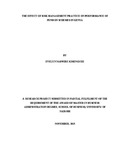| dc.description.abstract | Pension Schemes are the main sources of retirement income for millions of people in the world. Pension Schemes are also important contributors to the gross domestic product (GDP) of countries. This study focuses on pension Schemes in Kenya. Retirement income accounts for 68% of the total income of retirees in Kenya, while pension assets account for 30% of Kenya’s GDP. It is therefore important risk management practices of pension Schemes be managed effectively, not only in Kenya, but also in other countries. The primary objective of the study is to determine the effect of risk management practices to performance of Pension schemes in Kenya. More specifically, the study explores the effect risk management environment, risk measurement; risk mitigation and Internal Controls had positive effects on the performance of pension schemes in Kenya. A sample of 64 pension Schemes was drawn from the Kenyan Retirement Benefits Authority (RBA) register. The sample selection was based on the criterion that these pension funds should have been in existence within the period 2009 to 2013.This study used empirical design to investigate how pension scheme risks management practices affect performance of pension schemes by use of Sharpe Ratio. . Eighty (80) questionnaires were mailed to the trustees of these pension schemes. Sixty four (64) usable questionnaires were returned, which translated into a response rate of 80 per cent and historical monthly performance or returns data for all investments used i.e. fixed income, equities and offshore. Risk adjustment measures of Standard Deviation and Sharpe Ratio were applied to test the riskiness of the investments. Analysis of the data collected was summarised using tables in order to derive the study findings. Accordingly, the study viewed risk-returns in terms of the ratios and returns as per the sectors in investments for Pensions Funds in 64 schemes in Kenya. The initial analysis showed that there is a link between the asset allocation and risk factor at all the schemes with a high mean of 1.64%. However, the difference in returns for the various schemes seems to be insignificant. This implies that the assumed risks by policy makers might not have existed, but to be sure of the relationship between risk return and decision making, the regression results were clearly indicative that the variables can be linked. The study concludes that investment decisions should be based on the best estimates of as it remains a factor in the calculation of returns and is therefore prudent to use risk measures such as Sharpe Ratio in making investment decisions. Policy makers such as RBA, CMA, CBK and Ministry of Finance should review impact of risk on market development. | en_US |

